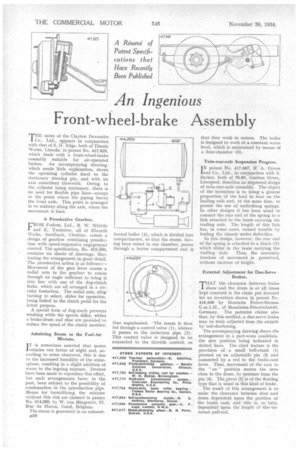An Ingenious Front-wheel-brake Assembly
Page 68

If you've noticed an error in this article please click here to report it so we can fix it.
THE name of the Clayton Dewandre Co., Ltd., appears in conjunction with that of S. H. Edge, both of Titanic Works, Lincoln, in patent No. 417,625, which deals with a front-wheel-brake assembly suitable for air-operated brakes. An accompanying drawing, which needs little explanation, shows i he operating cylinder fixed to the stationary steering pin, and with its axis coincident therewith. Owing to the cylinder being stationary, there is no need for flexible pipe lines—except at the point where the piping leaves the front axle. This point is arranged to be Midway along the axle, where the movement is least.
A Preselective Gearbox.
FROM Fodens, Ltd., R. W. Whittle and E. Twemlow, all of Elworth Works, Sandbach, Cheshire, comes a design of gearbox combining preselection with speed-responsive engagement control. The specification, No. 418,300, contains six sheets of drawings, illustrating the arrangement in great detail. The preselective action is as follows :— Movement of the gear lever causes a radial arm in the gearbos: to rotate through an angle sufficient to bring it into line with one of the dog-clutch forks, which are all arranged in a circular formation. The radial arm, after turning to select, slides for operation, being linked to the clutch pedal for the latter purpose.
A special form of dog-tooth prevents meshing while the. speeds differ, whilst a brake-drum and shoe are provided to reduce the speed of the clutch member.
Admitting Steam to the Fuel-Air Mixture.
iT is sometimes asserted that motor vehicles run better at night and, according to some observers, this is due to the increased humidity of the atmosphere, resulting in a slight addition of water, to the ingoing mixture. Devices have been made to reproduce this effect, but such arrangements have, in the past, been subject to the possibility of condensation in the introduction pipe. Means for humidifying the mixture without this risk are claimed in patent No. 414,269, by W. van Mingereot, 13, Rue du Huron, Gand, Belgium.
The steam is generated in an exhaustbfi0 heated boiler (4), which is divided into compaitments, so that the steam, having been raised in one chamber, passes through a hotter compartment and is thus superheated. The steam is then led through a control valve (1), whence it passes to the induction pipe (2). This control valve is designed to be connected to the throttle control, so that they work in unison. The boiler is designed to work at a constant water level, which is maintained by means of a float-chamber (3).
Twin-rear-axle Suspension Progress.
I N patent No. 417,687, R. A. Dyson and Co., Ltd., in conjunction with S. Barker, both of 76-80, Grafton Street, Liverpool, describes an improved design of twin-rear-axle assembly. The object of the invention is to bring a greater proportion of the load to bear on the leading axle and, at the same time, to permit the use of underslung springs. In other designs it has been usual to connect the rear end of the spring to a 'link attached to the beam carrying the trailing axle. The length of this link has, in some cases, caused trouble by fouling the chassis under deflection.
In this design, however, the rear end of the' spring is attached to a block (1) which slides in the beam carrying the
trailing axle. Thus, the necessary freedom of movement is permitted, without increase of height.
External Adjustment for Duo-Servo Brakes.
THAT the clearance between brake I shoes and the drum is at all times kept constant is the claim put forward for an invention shown in patent No. 416,630 by Deutsche Perrot-lBremse G.m.b.H., of Mannheim-Friedrichsfeld, Germany. The patentee claims also that, by this method, a duo-servo brake may be truly adjusted from the outside by rod-shortening.
The accompanying drawing shows the arrangement in a part-worn condition, the new position being indicated in dotted lines. The chief feature is the provision of a small bell-crank (1) pivoted on an adjustable pin (3) and connected by a rod to the brake-cam lever. Thus, movement of the cam to the " on " position moves the shoe close to the drum, by pressure from the pin (4). The pivot (2) is of the floating type that is usual in this kind of brake.
The result of this arrangement is to make the clearance between shoe and drum dependent upon the position of the brake cam, and this is, isituril, dependent upon the length of the -external pull-rod.




































































































